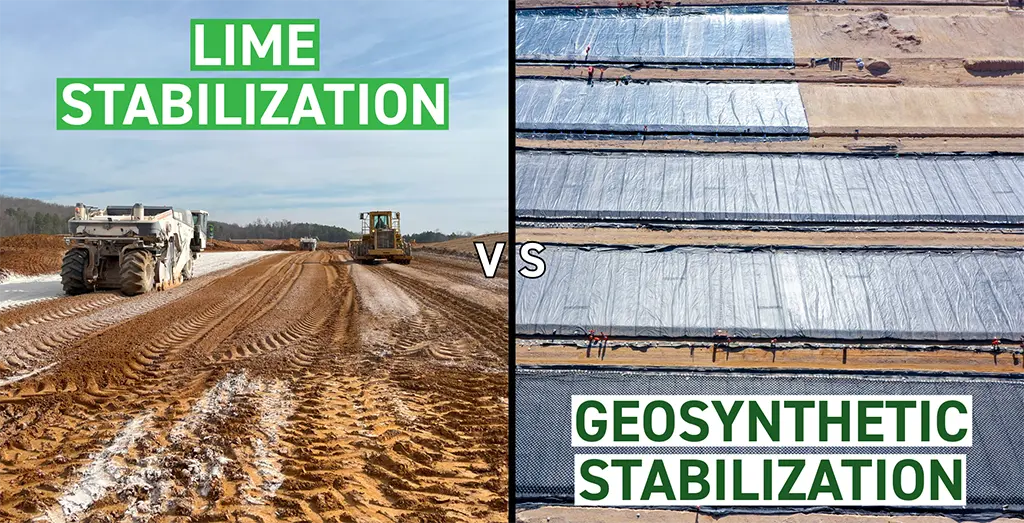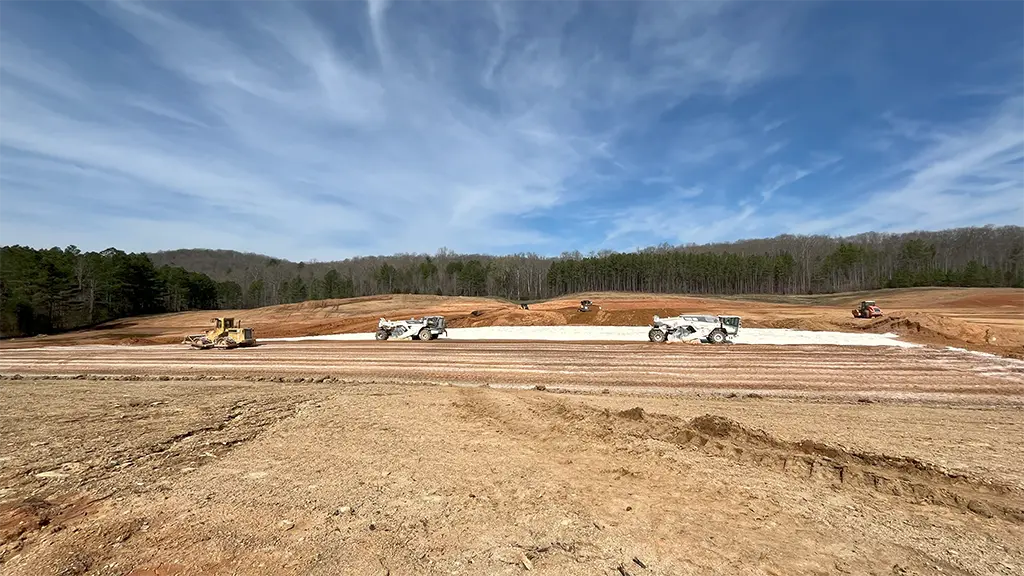Ground Control: Comparing Lime and Geosynthetics for Long-Lasting Stability

When building infrastructure on weak in-situ soils, a well-designed foundation is essential to ensure long-term resilience. Whether you’re constructing roads, embankments, or industrial platforms, ensuring subgrade stability is critical—not just for performance, but also for long-term cost-effectiveness and environmental responsibility. Two widely used methods—lime stabilization and geosynthetic stabilization—offer distinct benefits and features depending on the project’s goals and site conditions.
Get back to work with less downtime.
Introduction
While every soil type presents its own set of engineering challenges, high-plasticity clays are among the most problematic for construction. These soils are highly reactive to moisture, exhibiting significant shrink-swell behavior, reduced strength when wet, and vulnerability to freeze-thaw cycles—all of which can compromise the integrity of a structure’s or roadway’s foundation. When encountered on-site, these conditions must be mitigated to ensure a stable and reliable working platform. Lime stabilization addresses these issues through a chemical reaction that alters the soil’s properties, improving strength and reducing plasticity. In contrast, geosynthetics provide a mechanical solution, reinforcing the soil and distributing loads to enhance stability without altering the soil composition itself.
Stabilization Mechanisms
Lime
Lime stabilization works by transforming weak, moisture-sensitive clay soils into strong, durable subgrades through a powerful chemical process. When hydrated lime (calcium hydroxide, Ca(OH)2) or, more often, quicklime (calcium oxide, CaO) is introduced to clay-rich soils, it reacts with naturally occurring pozzolans—compounds like silica and alumina found in the soil’s mineral structure. In the presence of water, these reactions form calcium-silicate-hydrates (C-S-H) and calcium-aluminate-hydrates (C-A-H)—the same cementitious compounds that give concrete its strength. These bonds permanently alter the soil’s structure, increasing strength and stability over time. As a result, the required base course thickness may be reduced, or the enhanced strength of the treated soils can be incorporated into design calculations—leading to a more efficient and cost-effective pavement structure. Beyond long-term gains, lime also delivers immediate advantages: it dries out wet soils, reduces plasticity, and improves workability, making the subgrade construction-ready. Simply put, lime corrects overly wet and weak soils, allowing subgrade preparation and long-term stabilization to occur simultaneously. Achieving optimal results often requires a site-specific mix design which determines the right lime content and helps to verify suitability before mobilizing in the field.
Geosynthetics
Geosynthetic stabilization offers a mechanical approach to improving subgrade performance by reinforcing the soil without altering its chemical composition. Products such as geogrids, geotextiles, and geocells are placed within or beneath the subbase or subgrade to distribute loads, confine materials, and reduce deformation under stress. These materials create a reinforced composite section by transferring shear forces from the aggregate base into tensile forces within the geosynthetic, which can reduce the amount of base course material required. To ensure optimal performance, several critical factors must be considered. Whether using geogrids for reinforcement, geotextiles for separation, or geocells for confinement, the selected material must be compatible with the soil and capable of withstanding the anticipated loads. The degree of lateral restraint achieved depends on both the type of geosynthetic used and the quality and gradation of the base or subbase material placed over it. Design must also account for drainage, environmental conditions, and long-term durability. Because material properties vary widely, special attention should be given to tensile strength, puncture resistance, aperture or opening size, and stiffness. Hydraulic considerations—such as water flow, drainage, and potential for erosion or piping—are equally important. While geosynthetics provide a durable and effective solution across a variety of site conditions, their performance on weak in-situ soils requires specific considerations as they do not chemically modify the soil like lime does.
Installation
Lime
Proper application and mixing of lime are critical to maximizing the long-term performance of lime-stabilized soils. While some specialized equipment—such as spreaders and rotary mixers/reclaimers—is required, much of the necessary machinery is typically already available during site preparation. The process begins with uniformly spreading the specified amount of lime over the prepared subgrade, followed by thorough mixing with the in-place soil to initiate the chemical reactions. Water is added (either by injecting the proper amount of moisture into the mixing chamber of the reclaimer or by placing water on the ground with a water truck in a separate operation) to activate the lime and facilitate proper blending. After initial mixing, lime stabilized soils are usually allowed to mellow (sit undisturbed) for a short period to allow for soil modification and complete hydration. However, when tighter timelines occur, utilizing products such as lime kiln dust (LKD) or CQL can reduce the required mellow time due to higher surface area and volume ratio. The treated soil is then compacted to achieve the desired density and strength using a vibratory, footed roller followed by final rolling with a smooth drum roller and no vibration. Often a curing period is specified to allow the pozzolanic reactions to develop fully, resulting in a durable, high-performance subgrade. While curing will continue long after construction, initial curing should continue until an adequate working platform has developed to withstand site traffic without disturbance. Site-specific testing such as a proof roll can be considered to help expedite construction activities. Quality control measures, including field sampling and laboratory testing, help ensure the mix design is properly executed and the stabilized layer meets project specifications.
Geosynthetics
Geosynthetic installation for roadway stabilization involves careful planning and execution to ensure optimal performance. The process begins with site preparation (much like with lime), including grading and compacting the subgrade to create a smooth, stable surface. In cases of very soft soils (CBR <1.5), specialized equipment with low ground pressure may be required to minimize disturbance. The selected geosynthetic—such as a geogrid or geotextile—is then unrolled and placed directly over the prepared subgrade, ensuring proper alignment and minimal wrinkles or folds. Overlaps between adjacent rolls are required to maintain continuity and prevent weak points, with overlap widths specified by the manufacturer or design engineer as a function of the subgrade strength. Overlap widths may be as much as 36 inches for CBRs between 0.5 and 1 or may even require sewing to limit the potential for a slip plane. If sewing is required, seam strength becomes a critical factor in overall geosynthetic performance. Overlaps should be planned in the direction of fill placement to prevent peeling-back of the geosynthetic layer, and geosynthetics need to be cut to accommodate curves, manhole covers, and vertical utilities. Once in place, the geosynthetic is secured and covered with a layer of aggregate base material, which is carefully placed to avoid shifting or damaging the fabric. Special consideration should be given to fill placement procedures when the CBR<4. Compaction of the aggregate follows, locking the geosynthetic into the structure and enabling it to distribute loads and reinforce the roadway. Proper installation techniques, including tensioning and quality control checks, are essential to ensure the system performs as intended under traffic and environmental stresses.

Lime Installation

Geosynthetics Installation
Long-Term Performance
Lime
Lime stabilization offers a range of long-term performance benefits that make it a valuable solution for improving weak or problematic soils. One of the most significant advantages is the permanent increase in soil strength due to the formation of cementitious compounds. These chemical reactions also lead to a lasting reduction in plasticity, minimizing the soil’s tendency to swell or shrink with moisture changes. This is especially beneficial when treating expansive clays, which are notorious for causing structural damage. Additionally, lime-treated soils exhibit enhanced resistance to freeze-thaw cycles, helping maintain pavement integrity in colder climates. Over time, these stabilized layers can even undergo autogenous healing, where microcracks self-seal through continued pozzolanic activity, further extending the life of the pavement. Collectively, these improvements contribute to lower maintenance costs and a more durable, cost-effective pavement system that performs reliably over decades.
Geosynthetics
Geosynthetics can also enhance long-term pavement performance by providing mechanical reinforcement, separation, and drainage—depending on the type used. These functions work together to maintain the structural integrity of the pavement system. By distributing loads more evenly, geosynthetics help reduce rutting and deformation. They may also mitigate moisture-related issues by facilitating drainage, which lowers the risk of freeze-thaw damage. However, achieving these long-term benefits depends on proper material selection and correct installation practices.
Conclusion
When it comes to stabilizing wet, soft, or highly plastic soils, lime and geosynthetics each offer valuable benefits—but their mechanisms and long-term impacts differ significantly. Geosynthetics provide mechanical reinforcement, separation, and drainage, making them effective for improving load distribution and reducing deformation in a variety of conditions. However, they do not chemically alter the soil. In contrast, lime stabilization permanently transforms the soil’s structure through pozzolanic reactions, increasing strength, reducing plasticity, and enhancing resistance to moisture and freeze-thaw cycles. This makes lime a more robust and enduring solution for challenging subgrade conditions, particularly where long-term performance, durability, and reduced maintenance are priorities.
Benefits and Features Comparison
| Lime Stabilization | Geosynthetics | |
| Mechanism | Chemical reaction with clay minerals to form cementitious compounds | Physical reinforcement, separation, filtration, and drainage |
| Strength Improvement | Significant, permanent subgrade strength gain and reduction in plasticity through pozzolanic reactions | Enhances load distribution and reduces deformation in aggregate base course |
| Treatment of Expansive Clays | Highly effective; reduces swell potential and improves stability by lowering plasticity index | Limited effectiveness; may require combination with other treatments |
| Freeze-Thaw Resistance | Improved resistance due to modified and stabilized soil structure | Provides drainage and separation to reduce freeze-thaw damage |
| Autogenous Healing | Microcracks can self-seal over time through continued chemical reactions | No self-healing properties |
| Installation Requirements | Requires mixing, mellowing, compaction, and curing | Requires grading, proper placement, overlap and anchoring |
| Maintenance Impact | Reduces long-term maintenance through durable subgrade | Reduces maintenance by preserving layer integrity and preventing contamination |
| Best Use Cases | Wet, weak, or expansive clay soils requiring chemical stabilization | Soft soils, high-traffic areas, or where separation and drainage are critical |
We're here to help you find the best solution for your next project. Let's get started. Give me a call at 937-641-9901.

Josh Weser
Mintek Resources
Related Posts
Unlocking Pavement Potential: The Long-Term Value of Chemically Stabilized Subgrades
A Foundation in Crisis America’s roadways are the backbone of its economy and daily life, yet they continue to show signs of chronic underinvestment. According to the American Society of Civil Engineers’ 2025 Infrastructure Report Card, the nation’s infrastructure...
Save Time and Money with Mintek’s Lime Stabilization Calculator
Lime stabilization turns challenging soils into durable foundations suitable for the construction industry. When lime-based reagents interact with soil, a chemical process alters its characteristics - binding clay particles, reducing plasticity & shrink-swell...
Exploring The Application of Lime Stabilization in Soil
Creating a stable foundation is essential for any construction project, yet many construction sites face challenges with unsuitable soil conditions. Lime soil stabilization offers a proven, cost-effective solution for transforming problematic soils into reliable...